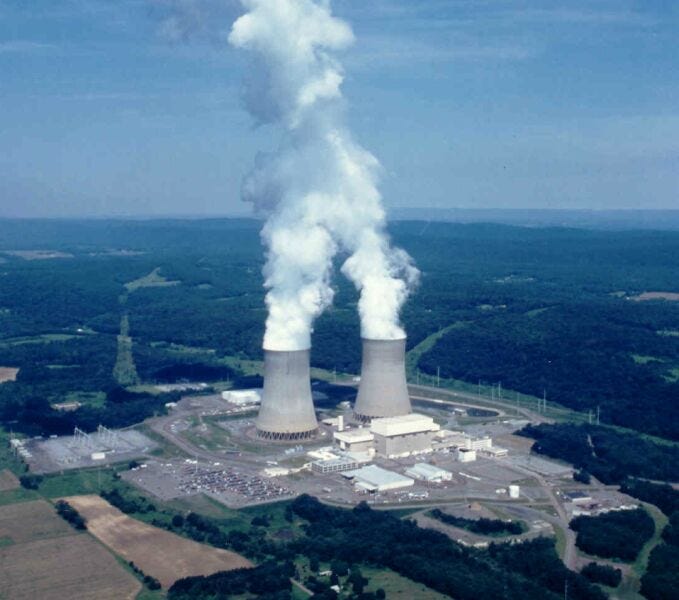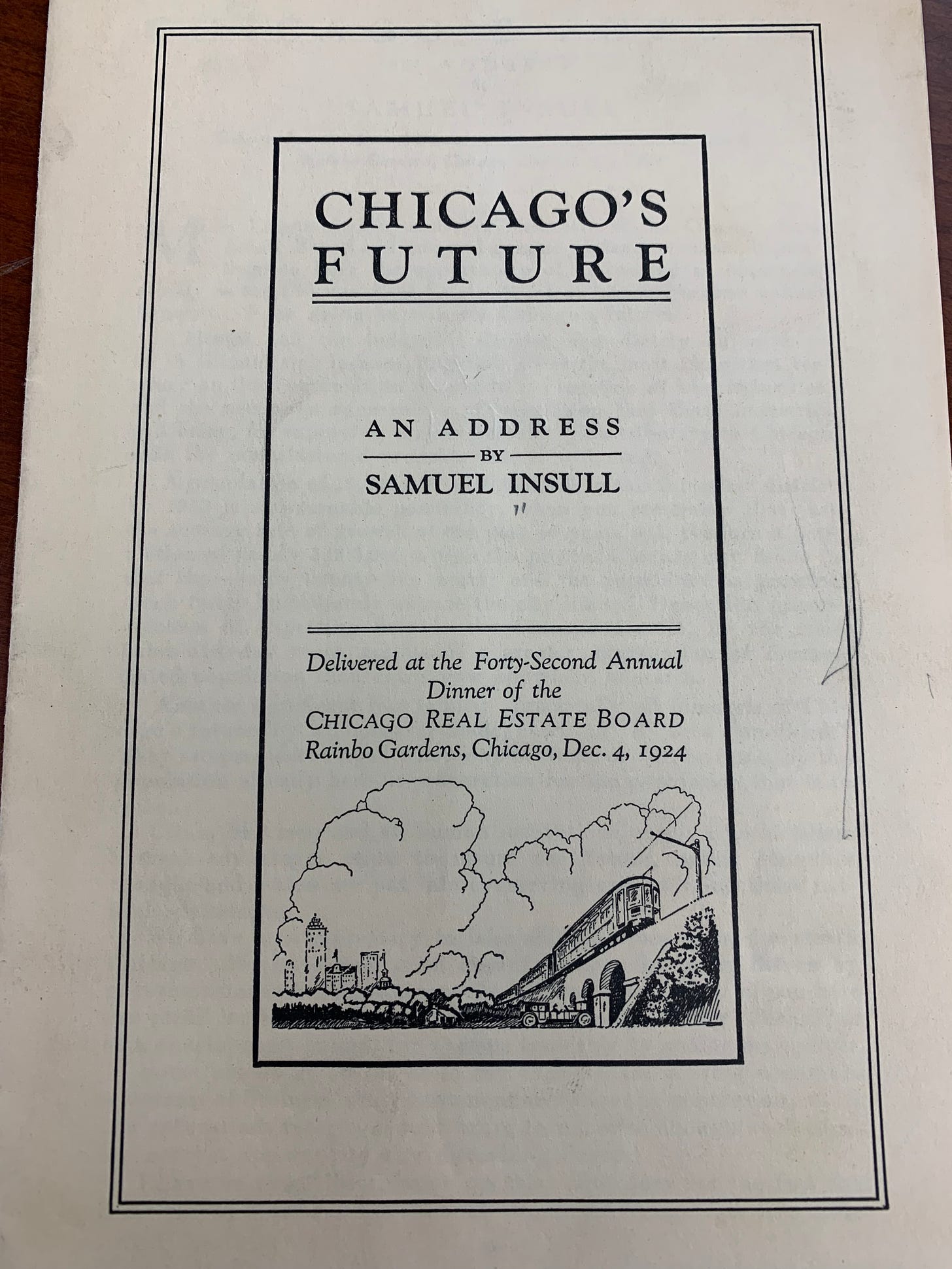The Arc of History Bends Toward Power Density
On AWS's new nuclear-powered data facility and "saying it with shovels"
In my last two posts, I took a look at grim developments in energy and infrastructure. Let’s try something positive.
Today, over at Grid Brief, I covered Amazon Website Service’s acquisition of Talen Energy’s nuclear-powered data center for $650 million. It’s sited beside the Susquehanna nuclear power plant in Pennsylvania. Here’s what AWS had to say about it:
To supplement our wind and solar energy projects, which depend on weather conditions to generate energy, we're also exploring new innovations and technologies, and investing in other sources of clean, carbon-free energy. This agreement with Talen Energy for carbon-free energy is one project in that effort.
In short, Amazon needs firm power around the clock. So much so that it plans on scaling the data center up to 960 MW. And Amazon’s not alone. In a piece I wrote for Grid Brief Premium earlier this year, I demonstrated that the expectations of growing power demand are disconnected from our current policy trajectory because we’re shedding baseload power sources like coal, and gaining more intermittent and non-dispatchable sources like wind and solar. In short, destabilizing supply while ramping up demand.
And much of that demand is expected to come from AI’s computational needs. More from this morning’s Grid Brief:
According to the Wall Street Journal, data centers accounted for 1% of the world’s electricity in 2010. Vrije Universiteit Amsterdam's School of Business and Economics told WSJ that it estimates “the amount of electricity required to power the world’s data centers could jump by 50%” by 2027, as a consequence of AI.
Meanwhile, the International Energy Agency expects “a return to growth in electricity demand of 1.5% on average” out to 2026 — an estimated third of which comes from the data center industry alone.
This is ultimately good news for nuclear power for several reasons. First, it’s a big victory for those who’ve been trying to communicate the value of nuclear’s affordable baseload power. Mark Nelson, the director of the Radiant Energy Group, ballparked AWS’s PPA with Talen at around $25 per MWh.
Second, as Nelson pointed out, it cracks renewable energy’s ESG hegemony. “This is colossal for the ‘Nuclear Energy as ESG’ story,” Nelson wrote.
The major tech companies, which are essentially all entirety of the ESG sector, were avoiding buying nuclear power, instead misleading the public for years about using 100% renewable even though they knew it wasn't true. Now, in order to accept the tech giants as ESG, major financial groups and the ESG ratings agencies that work with them will have to accept that these companies are openly powering themselves with zero-emission nuclear energy.
This change in sentiment was backed up by an industry insider I spoke with. “I can tell you from first hand meetings with their head of engineering (for all of AWS) that nuclear was nowhere in their dialog on zero emissions,” he told me.
“This is huge,” he added.
Thirdly, we’re seeing the demand for data computation create a consensus around nuclear in the halls of government, as evidenced by the Director of the Department of Energy’s Loan Program Office, Jigar Shah, in a recent Twitter thread.1
This is a big shift—Shah was something of a renewable energy fundamentalist, but seems to have peeled the scales from his eyes.
Now, I’m not saying that nuclear’s prayers are answered and it’s all plug and play from here. That’s clearly not the case. But, as I’ve been researching for my book on the history of the US power grid, I have had cause to visit the Chicago History Museum’s collection of Samuel Insull’s uncollected and/or privately printed speeches. And I’ve found some historical rhyming.
For those who don’t know, Insull brought forth the utility industry as we know it after working for Thomas Edison. Headquartered in Chicago, Insull saw the city explode with growth by the 1920s—its population had quadrupled between 1880 and 1920, from 500,000 souls to over 2 million. And though electric traction had made some headway in the city, the streets were still choked with slow-moving pedestrians, not to mention horses that shat by the hundreds of tons and pissed by the tens of thousands of gallons per annum. As
explains in his book A Question of Power: Electricity and the Wealth of Nations, most of the waste was piled into vacant lots—a great housing policy for thick clouds of flies that rained down disease onto the city. Speaking of rain, once rain water sluiced down the hillocks of dung and urine, it streamed out into the streets in rivulets of rancid sludge.The city’s concerns were both hygienic and economic. The waste problems were unbearable, and the congestion issues threatened to stagnate the city’s economic growth. Insull shared these worries as the situation approached a crisis point. In a 1924 speech, Insull called on Chicagoans to rise to the occasion through “an exercise of the vision and judgment and that action that enabled this city to rise Phoenix-like from its ashes” after the Chicago Fire of 1871 “and that produced that great monument to the energy and patriotism of our citizens, the Great White City of 1893.”
Insull told the audience that the time for talk was over. What Chicago needed was work. “SAY IT WITH SHOVELS,” he bellowed. He lived up to those words by consolidating, rationalizing, and expanding the city’s electric transit system—disappearing the waste and the gridlock at once.
What was true for Insull 100 years ago may be true for us now: all the debates about climate and power source supremacy may be settled by the raw facts of physics and the brute force of climbing up the energy ladder. A new wave of computational needs are coming and, without peer, nuclear fits the bill.
Soon, whatever remains to be said will be said with shovels.
If you liked this, there are several ways you can support my work.
Subscribe, or, if you’re feeling generous, upgrade to paid. All my content is free, but I greatly appreciate any extra support I receive:
Check out my other newsletter, Grid Brief. I cover energy news from all over the world, and premium subscribers get exclusive insights into international and domestic energy issues plus a weekly look under the hood of America’s power markets.
Share this post with friends!
For more about what this means for the AP1000 reactor, check out
‘s piece for her Substack, Elemental, which we republished at Grid Brief.







Saying it with shovels and engineers!